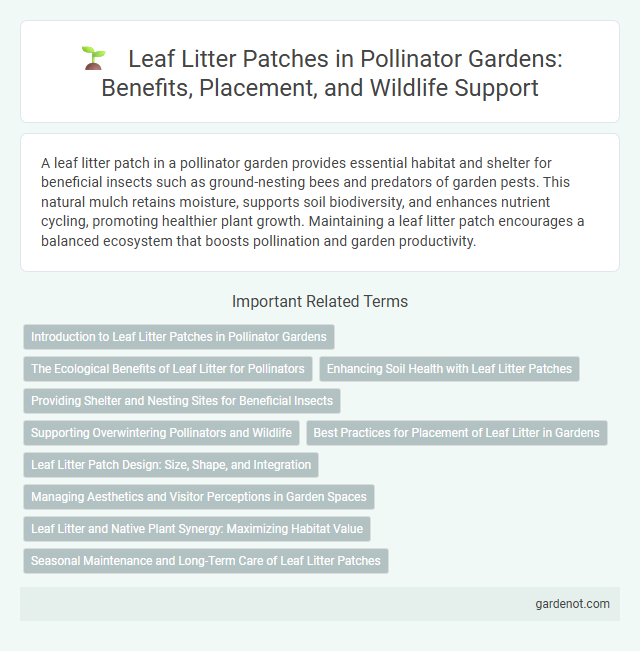A leaf litter patch in a pollinator garden provides essential habitat and shelter for beneficial insects such as ground-nesting bees and predators of garden pests. This natural mulch retains moisture, supports soil biodiversity, and enhances nutrient cycling, promoting healthier plant growth. Maintaining a leaf litter patch encourages a balanced ecosystem that boosts pollination and garden productivity.
Introduction to Leaf Litter Patches in Pollinator Gardens
Leaf litter patches in pollinator gardens serve as essential habitats for beneficial insects and microorganisms that support pollination processes. These decomposing leaves provide shelter, moisture retention, and nutrient cycling, creating a microenvironment conducive to pollinator nesting and foraging activities. Integrating leaf litter patches enhances biodiversity and promotes the ecological health of pollinator-friendly landscapes.
The Ecological Benefits of Leaf Litter for Pollinators
Leaf litter patches provide essential habitats and nesting sites for various pollinators, including native bees and beetles, enhancing biodiversity in pollinator gardens. The decomposing organic matter in leaf litter enriches soil fertility and moisture retention, fostering robust plant growth that supports pollinator forage. Moreover, these patches harbor beneficial microorganisms and aphid predators, contributing to ecosystem resilience and pollinator health.
Enhancing Soil Health with Leaf Litter Patches
Leaf litter patches play a crucial role in enhancing soil health within pollinator gardens by providing organic matter that enriches the soil with essential nutrients and improves moisture retention. These patches create a microhabitat that supports beneficial microorganisms and decomposers, which accelerate nutrient cycling and promote soil fertility. Maintaining leaf litter patches encourages a thriving soil ecosystem that supports robust plant growth and sustains pollinator populations.
Providing Shelter and Nesting Sites for Beneficial Insects
Leaf litter patches in pollinator gardens create essential microhabitats that provide shelter and nesting sites for beneficial insects such as solitary bees, beetles, and spiders. These decomposing leaves offer insulation and protection from predators and harsh weather, enhancing insect survival rates. Maintaining leaf litter supports biodiversity and promotes a balanced ecosystem by encouraging natural pest control and pollination.
Supporting Overwintering Pollinators and Wildlife
A leaf litter patch provides essential habitat for overwintering pollinators such as native bees, butterflies, and beneficial insects by offering shelter and insulation during cold months. It supports wildlife biodiversity by preserving microhabitats that sustain larvae and small mammals, fostering ecosystem health. Maintaining undisturbed leaf litter enhances soil fertility and natural pest control, crucial for sustainable pollinator gardens.
Best Practices for Placement of Leaf Litter in Gardens
Leaf litter patches should be placed in shaded or semi-shaded areas to provide shelter and overwintering habitat for pollinators like native bees and butterflies. Positioning leaf litter near native plants enhances shelter availability and facilitates easy access for pollinators. Avoid disturbing the leaf litter during fall and winter to maintain its ecological benefits and support pollinator conservation.
Leaf Litter Patch Design: Size, Shape, and Integration
A well-designed leaf litter patch should ideally cover at least 10-15% of the pollinator garden area to provide adequate shelter and breeding habitat for beneficial insects like beetles, spiders, and solitary bees. Irregular, natural shapes that mimic woodland edges enhance microhabitat diversity and encourage greater species richness by creating varied moisture and temperature gradients. Integrating leaf litter patches near flowering plants and nesting sites promotes seamless habitat connectivity, maximizing the ecological benefits within the garden ecosystem.
Managing Aesthetics and Visitor Perceptions in Garden Spaces
Leaf litter patches in pollinator gardens enhance habitat complexity and support beneficial insects by providing shelter and food resources. Managing aesthetics requires balancing natural ecological functions with visitor expectations, using design strategies such as defined borders or selective removal to maintain visual appeal. Educating visitors about the ecological importance of leaf litter fosters appreciation and reduces negative perceptions of garden tidiness.
Leaf Litter and Native Plant Synergy: Maximizing Habitat Value
Leaf litter patches create vital microhabitats that enhance soil moisture retention and support diverse insect populations essential for pollinators. The integration of native plants with abundant leaf litter fosters nutrient cycling and provides shelter for beneficial species like ground-nesting bees and decomposers. This synergy between leaf litter and native vegetation maximizes habitat complexity, promoting ecosystem resilience and pollinator health.
Seasonal Maintenance and Long-Term Care of Leaf Litter Patches
Leaf litter patches require seasonal maintenance to preserve their role as essential habitats for pollinators and beneficial insects during colder months. Regularly monitor and gently ruffle the leaf layer in early spring to promote aeration while avoiding disturbance to overwintering species. Long-term care involves adding fresh leaves annually and minimizing leaf removal to support biodiversity and soil health in the pollinator garden.
Leaf litter patch Infographic

 gardenot.com
gardenot.com